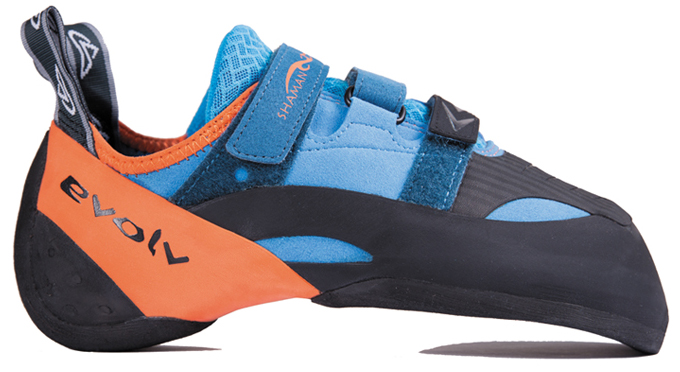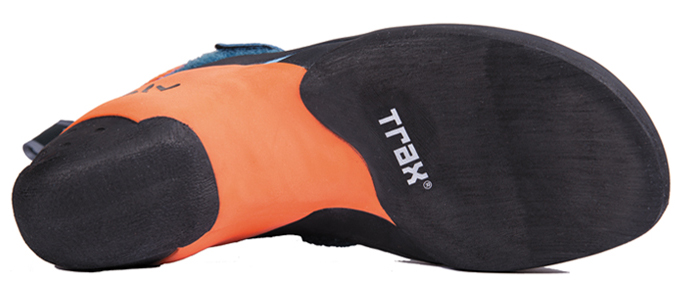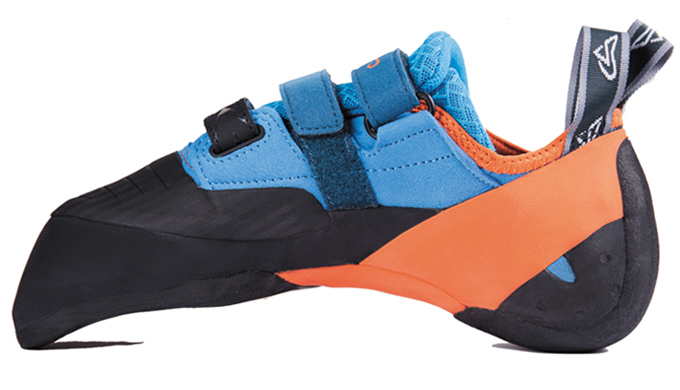
Evolv Shaman (2016)
Stated Features:
- Profile: Downturned asymmetry with “Knuckle Box”
- Upper: Synthetic (Synthratek VX upper)
- Lining: Unlined
- Midsole: 1.0 mm half-length “Love Bump” midsole
- Sole: 4.2 mm TRAX® SAS rubber, two-piece outsole
- Rand: VTR rand (thicker front toe area)
MSRP: $160
Size Tested: 13
Days Tested: 14
Test Locations: Rifle, Eldorado Canyon, Clear Creek Canyon, Rocky Mountain National Park, & South Platte, CO; Spearfish Canyon, SD
Intro
Last year Evolv revised the Shaman, a steep face-climbing shoe and the flagship of Chris Sharma’s signature line of shoes. This latest version of the shoe maintains the sport-climbing focus of the Shaman, but Evolv claims that minor adjustments to the construction bring “an improved fit in terms of engineered comfort and performance.” In addition to climbing with the new Shaman on many different types of rock, I also spoke with Evolv to get some more specifics on what exactly has been changed from the previous version and what they mean by “improved fit.” This review fleshes out what’s changed with the new Shaman, what hasn’t, and how the Shaman fits into the greater spectrum of aggressive climbing shoes.
Construction
The new Shaman, released in 2016, is built on the exact same last as previous generations, giving it mostly the same overall shape. If you’re new to the Shaman entirely, the last bears the asymmetry and down-camber you might expect from a high-end sport-climbing shoe. To place the Shaman in a larger context, its last is similar, at least in these characteristics, to La Sportiva’s PD 85 last, which is their most aggressive last. This puts the Shaman, at least in terms of overall geometry, in line with Sportiva shoes such as the Solution and Genius, and its shape is also similar to the Scarpa Instinct VS.

Under the toe box, the Shaman has what Evolv calls the “Love Bump,” a molded part of the midsole designed to maintain a concave shape underneath your toes. This does several things, including help maintain the desired shape of the shoe as well as reducing dead space in the front of the shoe, thereby bolstering the effect of the aggressive shape. Apart from the unique name, the Love Bump achieves more or less the same thing as La Sportiva’s P3 Platform, which appears in many of their shoes, including the Miura VS, Solution, Genius, and Katana Lace. Both the P3 Platform and Love Bump are rigid components of the midsole designed to keep your toes where they should be, and in both cases are very effective — they really help the toe box maintain it’s shape and take some pressure off your toes when standing on tiny holds.
Fit
I wore the Shaman in a 13, my street shoe size, and felt that was the right size. This is a bit more snug than the same size in the Genius, and roomier than the Five Ten Hiangle, but still felt like the right fit to fully take advantage of the shoe. The Shaman is a medium- to high-volume shoe, so if you have especially slender feet you may consider sizing down half a size, but I imagine most climbers will be best served in their street shoe size.
What’s New in the 2016 Version
The newest version of the Shaman sports some extra rubber on top of the toe box, and this rubber also wraps around the toe of the shoe for toe scums. The same three alternating velcro straps are back but are slimmer than those on the previous version.

When I spoke with Evolv, they told me that the 2016 Shaman uses the exact same last as previous versions. How, then, is the fit different, so much so that it’s the principle selling point of the new version? The answer, they explained, is less material throughout the shoe, even if the starting shape is the same. The older version of the Shaman had two layers of upper material all the way around the shoe, then the midsole, and then the rubber underneath.
Evolv decided that this contributed to a stiff feel that was clunkier than what they wanted. The 2016 Shaman, by contrast, employs the same stack of materials around the front of the shoe composed of the rubber, a midsole material, and the liner, but uses single layers throughout much of the upper. This is also true of the sole around midfoot: a single layer of upper material is wrapped in orange rubber. The effect of all this is a soft, pliable upper that conforms comfortably to the foot and an incredibly soft, flexible midsole, all while preserving the same feel in the toe box as the previous Shaman.
This is by far the biggest difference between this Shaman and the older iteration — the 2016 version has a softer feel that allows for more flex in the middle of the shoe. Greater pliability in the upper helps reduce hot spots and creates a more comfortable fit overall. Evolv further explained that one of their goals with this change was to make the Shaman suitable to a broader range of foot shapes. I can’t speak to this last point as I’ve only got two feet, but I can say that this new version is an improvement over the previous in terms of comfort, and more or less the same in terms of performance. On the whole, I found the fit of the new Shaman to be comparable to that of the La Sportiva Genius (review coming soon).
Performance
If you’ve used and liked the older Shaman, you can expect a similar experience from this model in terms of performance. The only change that I noticed while climbing was the aforementioned tail of rubber that extends from the toe cap along the inside edge. That was a smart move, and really does help for inside scums. Otherwise, it seems that Evolv went with the approach of not fixing something that isn’t broken when updating the Shaman.
If you’re new to the Shaman entirely, it’s a great high-end sport-climbing shoe. The shape of the toe box keeps your toes bent and pointed in, but not painfully so. The toe box also has some taper to the front, much like the SCAPRA Instinct or Sportiva Solution, which is important if you want to be able to toe-in on small pockets. By contrast, shoes like the Five Ten Hiangle or So Ill Street have rounded toe boxes that are fine for edging and smears but make pockets a challenge.

In terms of edging, the Shaman holds it’s own against top sport shoes like the Solution or Instinct, but doesn’t toe hook as well as either of those shoes. For toe hooking on edges, even small ones, the Shaman seems to do just fine, but it inspires somewhat less confidence when smearing using the top of the toe box compared to the Solution or Evolv Agro (review coming soon).
The Shaman is not an ultra-stiff shoe, so if vertical or more slabby climbing is your game and your main routes involve standing on thin edges, you might get more out of the stiffer Instinct or even less-aggressive shoes that have stiffer midfoot platforms and therefore require less effort from you feet and calves to maintain a stance.
This gets at an important insight into the Shaman: while it does many things well, it’s really built with overhanging terrain in mind. The strongest areas of the Shaman’s performance are pockets and toe-points, with an honorable mention to edging (the Shaman edges just fine, but eventually you tire out a little faster than with a stiffer shoe). This is the set of strengths that is useful on steep terrain, which makes that style a natural fit for the Shaman.
Beyond Steep Sport Climbs
I used the Shaman on a handful of trad climbs to find out how it might work as a work-horse shoe for someone who participates in a variety of climbing disciplines but only wants one shoe. In the trad climbing world of cracks and corners, the Shaman did surprisingly well.
Performance-wise, it climbed competently, and was surprisingly comfortable when used for jamming. The catch, for me, was that it was much more bearable in flaring cracks where the flare gives a little extra room for the toe knuckles while the shoe’s taper can get far enough into the crack to still get some purchase. In addition, the softer nature of the shoe lets you fidget around in a flare and avoid serious discomfort. For laser cut cracks, however, the Shaman was too painful to imagine using regularly because of the aggressive shape. All told, this is about as well as a performance sport shoe can do in the crack climbing arena — good enough for occasional use on granite, but not a wise idea for hardcore splitters.
Price
It is worth pointing out that, at $160, the 2016 Shaman is cheaper than almost every other shoe in the high-performance sport-climbing class. For the sake of comparison, Tenaya’s Lati and Tarifa are the closest at $165, the SCARPA Instinct comes with a $170 price tag, and La Sportiva’s Solution, Testarossa, and Genius set you back $180, $180, and $195, respectively. This makes the Shaman one of the best value high-performance shoes I’ve used.
Bottom Line
The updated Shaman takes an already established, high-end sport-climbing shoe and makes minor adjustments to improve comfort while not changing the nature of the shoe. The Shaman is competitive on it’s merits alone, and it’s an even more compelling shoe once price is considered. Climbers looking for a shoe for thin, vertical climbs with sustained edging might consider a shoe that is stiffer underfoot, but those climbers looking to graduate to steep / overhanging terrain or pursue projects on pocketed limestone will find a great fit for that style in the Shaman, and at a lower price point than any other shoe with similarly high levels of performance.
